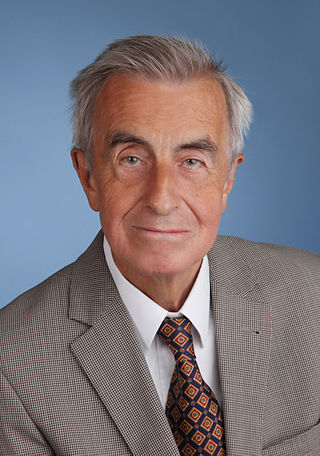In mathematics, the complete Fermi–Dirac integral, named after Enrico Fermi and Paul Dirac, for an index j is defined by

Nikoloz (Niko) Muskhelishvili was a Soviet Georgian mathematician, physicist and engineer who was one of the founders and first President (1941–1972) of the Georgian SSR Academy of Sciences.
George Neville Watson was an English mathematician, who applied complex analysis to the theory of special functions. His collaboration on the 1915 second edition of E. T. Whittaker's A Course of Modern Analysis (1902) produced the classic "Whittaker and Watson" text. In 1918 he proved a significant result known as Watson's lemma, that has many applications in the theory on the asymptotic behaviour of exponential integrals.
The Bôcher Memorial Prize was founded by the American Mathematical Society in 1923 in memory of Maxime Bôcher with an initial endowment of $1,450. It is awarded every three years for a notable research work in analysis that has appeared during the past six years. The work must be published in a recognized, peer-reviewed venue. The current award is $5,000.
George Yuri Rainich was a leading mathematical physicist in the early twentieth century.
In mathematics, the method of matched asymptotic expansions is a common approach to finding an accurate approximation to the solution to an equation, or system of equations. It is particularly used when solving singularly perturbed differential equations. It involves finding several different approximate solutions, each of which is valid for part of the range of the independent variable, and then combining these different solutions together to give a single approximate solution that is valid for the whole range of values of the independent variable. In the Russian literature, these methods were known under the name of "intermediate asymptotics" and were introduced in the work of Yakov Zeldovich and Grigory Barenblatt.
Valentine "Valya" Bargmann was a German-American mathematician and theoretical physicist.
In mathematics, secondary calculus is a proposed expansion of classical differential calculus on manifolds, to the "space" of solutions of a (nonlinear) partial differential equation. It is a sophisticated theory at the level of jet spaces and employing algebraic methods.
Edward Thomas Copson FRSE was a British mathematician who contributed widely to the development of mathematics at the University of St Andrews, serving as Regius Professor of Mathematics amongst other positions.
James Alexander Shohat was a Russian-American mathematician at the University of Pennsylvania who worked on the moment problem. He studied at the University of Petrograd and married the physicist Nadiascha W. Galli, the couple emigrating from Russia to the United States in 1923.
Eldon Robert Hansen is an American mathematician and author who has published in global optimization theory and interval arithmetic.
Onorato Timothy O'Meara was an American mathematician known for his work in number theory, linear groups and quadratic forms. He was provost emeritus and professor emeritus of mathematics at the University of Notre Dame.
In applied mathematics, oblate spheroidal wave functions are involved in the solution of the Helmholtz equation in oblate spheroidal coordinates. When solving this equation, , by the method of separation of variables, , with:
Alexander G. Ramm is an American mathematician. His research focuses on differential and integral equations, operator theory, ill-posed and inverse problems, scattering theory, functional analysis, spectral theory, numerical analysis, theoretical electrical engineering, signal estimation, and tomography.
The so-called double-well potential is one of a number of quartic potentials of considerable interest in quantum mechanics, in quantum field theory and elsewhere for the exploration of various physical phenomena or mathematical properties since it permits in many cases explicit calculation without over-simplification.
Mark Stern is an American mathematician whose focus has been on geometric analysis, Yang–Mills theory, Hodge theory, and string theory.
Periodic instantons are finite energy solutions of Euclidean-time field equations which communicate between two turning points in the barrier of a potential and are therefore also known as bounces. Vacuum instantons, normally simply called instantons, are the corresponding zero energy configurations in the limit of infinite Euclidean time. For completeness we add that ``sphalerons´´ are the field configurations at the very top of a potential barrier. Vacuum instantons carry a winding number, the other configurations do not. Periodic instantons were discovered with the explicit solution of Euclidean-time field equations for double-well potentials and the cosine potential with non-vanishing energy and are explicitly expressible in terms of Jacobian elliptic functions. Periodic instantons describe the oscillations between two endpoints of a potential barrier between two potential wells. The frequency of these oscillations or the tunneling between the two wells is related to the bifurcation or level splitting of the energies of states or wave functions related to the wells on either side of the barrier, i.e. . One can also interpret this energy change as the energy contribution to the well energy on either side originating from the integral describing the overlap of the wave functions on either side in the domain of the barrier.

Harald J.W. Mueller-Kirsten is a German theoretical physicist specializing in Theoretical particle physics and Mathematical physics.
Kang-Tae Kim is a South Korean mathematician. He is a professor of mathematics at Pohang University of Science and Technology, and is the head of the Center for Geometric Research at the Center for Leading Research. He is one of executive editors of Complex Analysis and its Synergies, an international journal published by Springer-Verlag.
Duong Hong Phong is an American mathematician of Vietnamese origin. He is a professor of mathematics at Columbia University. He is known for his research on complex analysis, partial differential equations, string theory and complex geometry.

